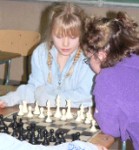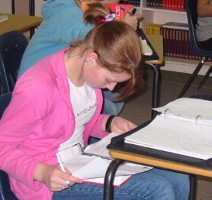 Memories are stored in the brain. We'll describe the various types of memory and how they work, with some examples. Then we'll show you how to apply what we know about memory to help make you a better student! There are actually three types of memory storage in your brain:
Sensory Memory Sensory memory provides temporary storage of information that your brain receives from the five senses. The information is deleted after a few seconds. Things you see, hear, feel, taste and smell are all around you. If all this constantly changing information bombarding your senses was permanently recorded in your memory, your brain, remarkable as it is, would probably become overloaded very soon after birth! Instead, what happens is that these vast amounts of sensory information are held temporarily in the sensory memory ... just long enough for us to decide whether they are important or not. - If they attract our attention, we'll take notice of them and store them in short-term memory (see below). - If they aren't important, they are discarded. For example, suppose you are walking down a busy street. Vehicles of all makes and colours are passing you on the road. You actually see all the vehicles, but this information only remains in your brain for a few seconds. If you don't take any notice of the vehicles, you won't be able to remember anything about them later. The brain stores things not so much like a sponge, but rather as a sieve; it knows what to get rid of. Short-Term Memory Short-term memory provides temporary storage of small amounts of information you've focused your attention on. The information is deleted after about 30 seconds or so. This is the memory storage you use when you look up a phone number and remember it just long enough to press the buttons on the phone. A minute or two later you won't be able to remember the number. How much can you store in your short-term memory? There is evidence to suggest that you can remember up to about nine bits of information ... like numbers or letters. However, short-term memory will also let you store information in 'packets', or 'chunks', which increases the amount of information you can briefly retain. For example, if you were shown this list of letters briefly and asked to remember it, you probably couldn't ... there is too much information for your short-term memory to hold: AAACBCFHSABWCS6852006RCMP However, if you split the data into chunks: AAA CBC FHS AB WCS 685 2006 RCMP where you can assign some sort of meaning to each group, some of which may be acronyms, ... you may be able to retain this larger amount of information in your short-term memory, even though it normally can hold only about nine things. Long-Term Memory Long-term memory provides permanent storage for an unlimited amount of data.  The brain can store information in its long-term memory indefinitely, if we ignore the effects of diseases of the brain. Also, there does not seem to be any limit to how much information can be stored! The brain can store information in its long-term memory indefinitely, if we ignore the effects of diseases of the brain. Also, there does not seem to be any limit to how much information can be stored!What is much more crucial is how the brain is able to retrieve this information. In fact, our brain often lets us down, seeming to refuse to divulge that familiar person's name, or the answer to a test question, ... information we know, but for some reason just can't access at the moment. More on this later. Things that can impair the storage of information in long-term memory:
How is information transferred from one memory system to another? Information from our sensory memory is moved to short-term memory only if we focus our attention on it. Information from short-term memory is transferred to long-term memory by focusing our attention on it and by thinking about it, and also by considering its meaning, and relating it to other information already stored in long-term memory. An example might be what happens when you're watching a headline news channel on TV. If you're not paying close attention to the scrolling list of headlines at the bottom of the screen, you won't remember them later; they are temporarily stored in your sensory memory, and then deleted only a second or two later. But if something catches your interest ... perhaps the score in an NHL game you missed ... so that you glance at that particular fact ... you'll remember it briefly. It will be transferred to your short-term memory for a while. If you actually cared about what the score was, thought carefully about it and how it might affect the team's chances for making the playoffs, the fact will be transferred to your long-term memory, and you'll be able to recall it later. In addition to the three ways your brain stores memories described above, there are also different types of memories: Semantic Memory This is memory of abstract information about the world; facts that weren't necessarily gathered by the senses. This type of memory stores such things as 'Are cats mammals?', 'What is the population of Canada?', 'How do you solve a second degree polynomial equation?', and 'How long does it take to cook hamburgers?'. It's the storehouse of information containing all the facts about the world that you've learned in your lifetime.  Procedural Memory
Procedural Memory This type of memory contains information about how to perform various skilled tasks, like putting on a shirt, tying your shoes, or driving a car. It can also include procedures for performing pencil-and-paper tasks, like factoring a polynomial. Episodic Memory This type of memory is formed from things we have experienced first hand. It lets you remember things like how it felt to kiss for the first time, the name of your grade three teacher, and the song you really liked when you were nine years old. Interestingly, we all suffer from 'infantile amnesia', which is the inability to recall events stored in episodic memory that happened in the first two or three years of our lives. It doesn't matter how elaborate you make that birthday party for your one-year old ... she won't remember it when she's grown up! (Of course, the brain at that age still stores semantic and procedural memories, since the child is learning to talk, remember things, and walk). Why infants cannot retain episodic memories of things that happen to them is not fully understood. Some episodic memories are enhanced, both in detail and the ability to recall them, if we underwent an emotional upheaval as they occurred. Many people can recall exactly where they were and what they were doing when the World Trade Center towers collapsed, or when the first space shuttle exploded on take-off. (I have a very strong memory of the elementary playground and school doors, as well as the people around me, when someone came out to the playground to tell us that President Kennedy had been shot). However, recent research has shown that such memories, while vivid, are sometimes not accurate.  We often make use of all three types of memory at once. For example, when you're writing a
test in school, you will remember facts from your semantic memory, but along with these
will be procedural memories (how to hold a pencil, or how to fill in the computer-scored
answer sheet), as well as episodic memories (what the last test you wrote was like).
We often make use of all three types of memory at once. For example, when you're writing a
test in school, you will remember facts from your semantic memory, but along with these
will be procedural memories (how to hold a pencil, or how to fill in the computer-scored
answer sheet), as well as episodic memories (what the last test you wrote was like).Chess is an activity that uses not only all three types of memory, but also requires a lot of thinking as well, involving areas of the brain including the frontal lobe. How can you 'forget' information that's in your long-term memory? For example, you are supposed to show up at a meeting; you know the time and place, and have known it for a week. But on the day of the meeting, you forget to go! What happened? The problem here is that you didn't store enough 'retrieval clues' to help you recall the memory at the right time. The memory and information was all stored, but there was no stimulus to help you remember it. Tying a string around your finger to help you recall something really does work, but we usually use more subtle methods ... discreet sticky-note reminders, or an agenda. How Students Can Use Information About Memory As a student you can use the information described above to do better in school! In Class: As the teacher is explaining things, if you aren't paying attention, the information probably won't make it past your sensory memory. If you want to learn the material well enough to recall it later, you will have to engage your short- and long-term memories. You can do this by focusing on what the teacher is saying, and becoming involved with the material ... doing deep processing. Think about what's being said or written. Ask questions if you don't understand something. Repeat what you've learned, orally, to the teacher or to a fellow student. Copy it in your own words into your notebook. Include diagrams or charts to relate different facts together. Think about how the new information relates to what you have already learned. Practice it. Good teachers will help you to do all of this. They will ask you questions, forcing you to think about the material and express what you know verbally. They will give you a chance to discuss it with someone else, and they will help you relate it to previously learned facts. They will even let you practice it by assigning homework! But if you really want to learn and remember, the onus will be on you to help out the process. If you tune out, or repeatedly reply with 'I don't know', or don't participate in discussions, or don't do the homework, then you won't be learning as thoroughly as you could be.  Studying for Tests and Exams:
Studying for Tests and Exams:As a student you should see your teacher for help with material you didn't learn properly the first time. But even more importantly, you need to review so that you can remember all of the information that you did learn already. This review might involve reading your notes (in Social Studies or Language Arts) or redoing problems (in Mathematics or Science). The idea is that everything in your long-term memory pertaining to the subject should be correct, and ingrained; reviewing is a form of deep processing that will make sure it stays there. Just as described earlier, when reviewing you need to:

|